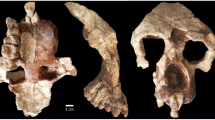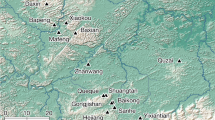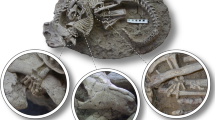Abstract
Hipparion species are important markers in faunal correlations. Their appearance is normally taken to define the boundary between the Miocene and Pliocene in continental deposits1. The genus is thought to have evolved in North America, probably around 12 million years ago2, and the spread of early, primitive Hipparion species to Eurasia has consequently been presumed to have occurred at this time, although it might have happened earlier if Hipparion older than 12 million years is dated in North America. The relative age of the faunas of the classic Siwalik deposits of north-west India and Pakistan is of considerable interest for the dating of the fossil primates Dryopithecus and Ramapithecus. The age of these primates is important because Ramapithecus has been recognized as the earliest probable hominid and it may lie in the direct line of human ancestry.
This is a preview of subscription content, access via your institution
Access options
Subscribe to this journal
Receive 51 print issues and online access
$199.00 per year
only $3.90 per issue
Buy this article
- Purchase on Springer Link
- Instant access to full article PDF
Prices may be subject to local taxes which are calculated during checkout
Similar content being viewed by others
References
Colbert, E. H., Trans. Amer. Phil. Soc., N.S., 36, 1 (1935).
Evernden, J. F., Savage, D. E., Curtis, G. S., and James, J. T., Amer. J. Sci., 262, 145 (1964).
Lewis, G. E., Amer. J. Sci., 33, 191 (1937).
Kurtén, B., in Evolution and Hominization, second ed. (edit. by Kurth, G.), 58 (Gustav Fischer Verlag, 1968).
Dehm, R., Bayer. Akad. Wiss., N.F., 114, 1 (1963).
Pilgrim, G. E., Rec. Geol. Surv. India, 43 (4), 264 (1913).
Crusafont-Pairo, M., Ann. Paléont., 40, 13 (1954).
Arambourg, C., Publ. Surv. Géol. Algerie Pal., 4, 1 (1959).
Simons, E. L., and Pilbeam, D. R., Folia Primat., 3, 81 (1965).
Simons, E. L., Nature, 221, 448 (1969).
Hussain, S. T., Bayer. Akad. Wiss., N.F. (in the press).
Author information
Authors and Affiliations
Rights and permissions
About this article
Cite this article
SIMONS, E., PILBEAM, D. & BOYER, S. Appearance of Hipparion in the Tertiary of the Siwalik Hills of North India, Kashmir and West Pakistan. Nature 229, 408–409 (1971). https://doi.org/10.1038/229408a0
Received:
Issue Date:
DOI: https://doi.org/10.1038/229408a0
Comments
By submitting a comment you agree to abide by our Terms and Community Guidelines. If you find something abusive or that does not comply with our terms or guidelines please flag it as inappropriate.



